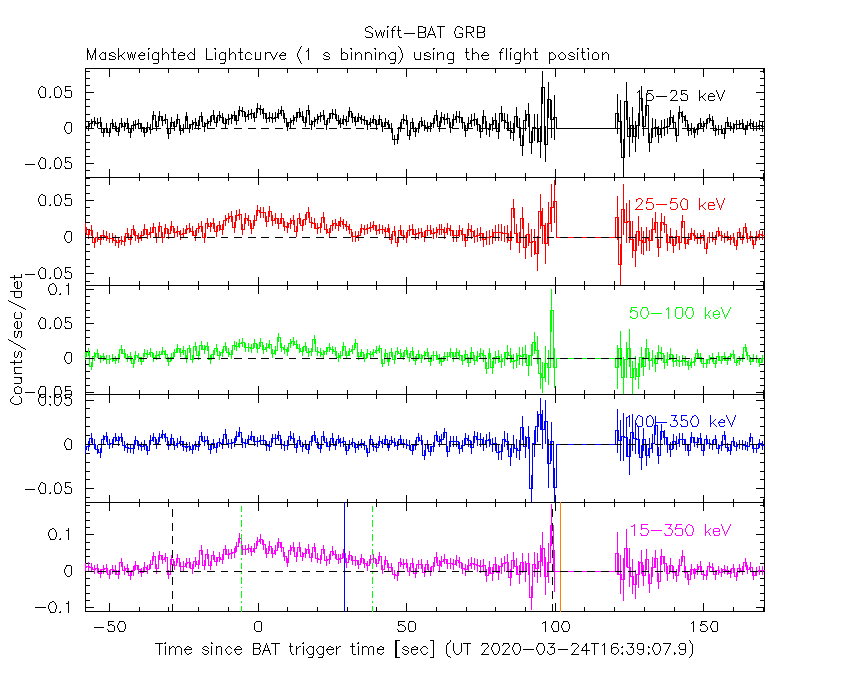
S. Dichiara (NASA/GSFC/UMCP), V. D'Elia (ASDC) and A.A. Breeveld (UCL-MSSL) for the Swift team
At 16:39:07 UT, the Swift Burst Alert Telescope (BAT) triggered and located GRB 200324A (trigger=963260) (Dichiara et al. GCN Circ. 27428). Swift slewed immediately to the burst. At the time of the trigger, the initial BAT position was 128° from the Sun (9.4 hours West) and 133° from the 0%-illuminated Moon. Table 1 contains the best reported positions from Swift, and the latest XRT position can be viewed at http://www.swift.ac.uk/xrt_positions.
Table 2 is a summary of GCN Circulars about this GRB from observatories other than Swift.
Standard analysis products for this burst are available at https://gcn.gsfc.nasa.gov/swift_gnd_ana.html.
As reported by Ukwatta et al. (GCN Circ. 27443),
the BAT ground-calculated position is RA, Dec = 222.682, 35.931 deg which is RA(J2000) = 1
The mask-weighted light curve (Figure 1) shows a weak pulse that starts at ~T-40 s, peaks at ~
The time-averaged spectrum from T-38.1 to T+100.4 s (before the burst went out of the BAT FOV) is best fit by a simple power-law model.
The power law index of the time-averaged spectrum is 1.72 ± 0.15.
The fluence in the 15-150 keV band is 2.3 ± 0.2 x 1
The results of the batgrbproduct analysis are available at https://gcn.gsfc.nasa.gov/notices_s/963260/BA/.
Analysis of the initial XRT data was reported by D'Elia et al. (GCN Circ. 27435). We have analysed 15 ks of XRT data for GRB 200324A, from 181 s to 120.9 ks after the BAT trigger. The data comprise 136 s in Windowed Timing (WT) mode (the first 1 s were taken while Swift was slewing) with the remainder in Photon Counting (PC) mode. The enhanced XRT position for this burst was given by Beardmore et al. (GCN Circ. 27430).
The light curve (Figure 2) can be modelled with a series of power-law decays. The initial decay index is α=3.78 (+0.55, -0.23). At T+334 s the decay flattens to an α of 1.89 (+0.59, -0.23). The light curve breaks again at T+874 s to a decay with α=0.89 (+0.09, -0.10), before a final break at T+18.4 ks s after which the decay index is 1.9 (+0.6, -0.3).
A spectrum formed from the WT mode data can be fitted with an absorbed power-law with a photon spectral index of 2.48 (+0.13, -0.11). The best-fitting absorption column is 1.49 (+0.28, -0.26) x 1
A summary of the PC-mode spectrum is thus:
Total column: 2.7 ± 0.7 x 1
Galactic foreground: 1.1 x 1
Excess significance: 6.4 σ
Photon index: 1.94 (+0.18, -0.17)
The results of the XRT team automatic analysis are available at http://www.swift.ac.uk/xrt_products/00963260.
The Swift/UVOT began settled observations of the field of GRB 200324A 215 s after the BAT trigger
(Breeveld and Dichiara GCN Circ. 27439).
No optical afterglow consistent with the XRT position (Beardmore et al. GCN Circ. 27430) is detected in the initial UVOT exposures.
Table 3 gives preliminary
magnitudes using the UVOT photometric system
(Breeveld et al. 2011, AIP Conf. Proc., 1358, 373).
No correction has been made for the expected extinction in the Milky Way
corresponding to a reddening of

Figure 1. The BAT
mask-weighted light curve in the four individual and total
energy bands. The units are counts

Figure 2. The XRT light curve.
Any data from a crosshatched region are not included in the fit.
| RA (J2000) | Dec (J2000) | Error | Note | Reference |
|---|---|---|---|---|
| 1 |
+35°56'30.3" | 1.4" | XRT-final | UKSSDC |
| 1 |
+35°56'30.2" | 1.7" | XRT-enhanced | Beardmore et al. GCN Circ. 27430 |
| 1 |
+35°55'51.0" | 1.1' | BAT-refined | Ukwatta et al. GCN Circ. 27443 |
| Band | Authors | GCN Circ. | Subject | Observatory | Notes |
|---|---|---|---|---|---|
| Optical | Lipunov et al. | 27427 | Swift GRB200324.69: Global MASTER-Net observations report |
MASTER | |
| Optical | Hosokawa et al. | 27429 | MITSuME Akeno optical upper limits | MITSuME Akeno | upper limits |
| Optical | Stecklum et al. | 27431 | Tautenburg observations | Tautenburg | |
| Optical | Fynbo et al. | 27432 | NOT optical upper limit | NOT | upper limits |
| Optical | Vinko et al. | 27433 | Konkoly Obs. optical upper limit | Konkoly | upper limits |
| Optical | Strausbaugh and Cucchiara | 27436 | LCO Optical Upper Limit | LCO | upper limits |
| Optical | Belkin et al. | 27440 | TSHAO optical upper limit | Zeiss-1000 | upper limits |
| Optical | Nakamura and Sakamoto | 27445 | AROMA-N Optical Observation | AROMA-N |
| Filter | Exp(s) | Mag | ||
|---|---|---|---|---|
| whit |
215 | 365 | 147 | >21.0 |
| 374 | 624 | 246 | >20.6 | |
| white | 215 | 1376 | 373 | >21.7 |
| v | 704 | 1427 | 78 | >18.9 |
| b | 630 | 1527 | 97 | >19.8 |
| u | 374 | 1327 | 304 | >20.2 |
| w1 | 754 | 1477 | 78 | >19.1 |
| w2 | 1381 | 1401 | 19 | >19.1 |
Table 3. UVOT observations reported by Breeveld and Dichiara (GCN Circ. 27439). The start and stop times of the exposures are given in seconds since the BAT trigger. The preliminary 3-σ upper limits are given. No correction has been made for extinction in the Milky Way.
March 27, 2020